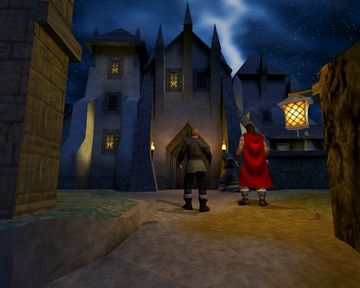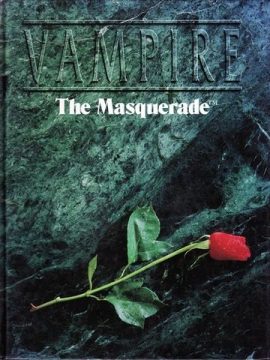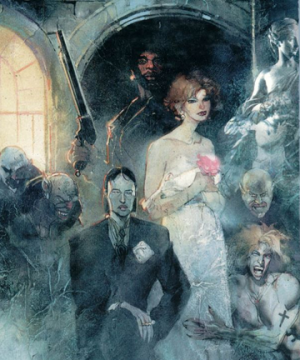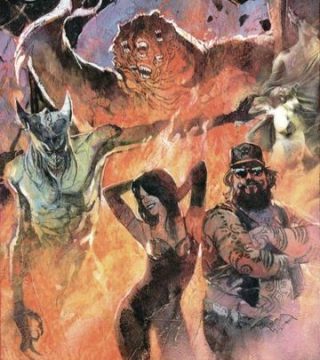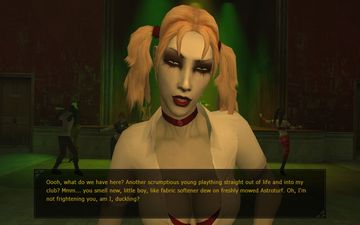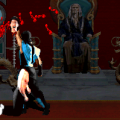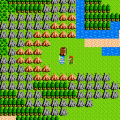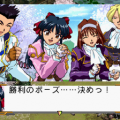- Vampire: The Masquerade (Introduction)
- Vampire: The Masquerade – Redemption
- Vampire: The Masquerade – Bloodlines
At the dawn of the 1990s, pen-and-paper RPGs were trying to reinvent themselves by going off the beaten track. Mark Rein-Hagen, who already conceived Ars Magica, White Wolf’s first success a few years prior, raised some good questions: what if the character’s nemesis wasn’t a powerful dragon or some other monster but rather, simply himself? What if the setting focused on internal conflict rather than classic power fantasy? Those questions would end up being at the core of his next game: Vampire – The Masquerade. A huge success at the time, V:TM puts the players in the shoes of newborn vampires discovering the joys of (un)life.
In this setting, vampire physiology is a bit different from typical pop culture representation. Turning a human into a vampire is a complex process that can’t be done accidentally. Stakes only paralyze them. Without blood, a vampire won’t die but instead fall into torpor for a very long time…years, centuries, even longer. Like wine, vampiric power is defined by age – the older one is, the stronger it gets. Still, a “true death” can be offered via fire, sun or extreme damage.
Each undead is bound to an amoral compulsion called “The Beast”, symbolizing its predatory essence. If the vampire doesn’t feed, is insulted or confronted by fire, the beast might “take over” and try to fulfill inhuman urges. To prevent loss of control, each vampire follows a strict moral path based on the concept of “humanity”. The more humanity a vampire has, the more human he acts and feels. Doing gruesome things tend to lower that score and brings them closer to The Beast. Therefore, drama comes from the slow but inevitable descent into the depravity of a vampire. “I am a monster lest I become a monster”. The second core element revolves around politics. Indeed, the “Kindred”, as they call themselves as opposed to the human “Kine”, have a complicated political life based upon clans, sects, and taboos. All of these rules come from ancient history.
Vampires are born from Cain, the slayer of Abel, cursed by God to wander the earth for eternity. The closer a vampire is to Cain (the first generation), the more powerful they are. Technically, the 13th generation is the weakest and the last one to appear. Beyond that, the curse of Cain is too weak to spread. Each of the grandchildren of Cain, called the “Antideluvians”, created its own clan, passing specific blessings (and a curse) through its own lineage. Vampire blood is a powerful drug for mortals, turning them into “ghouls”, thralls to their vampiric master. Drinking blood from another vampire produces a similar effect, slowly “blood-bonding” the drinker to his savior.
So why is it called the “Masquerade”? Well, after being sucked dry for centuries, humans couldn’t bear it anymore. Around the 14th century, the Inquisition eventually set ablaze Europe’s vampiric population. Young vampires saw an opportunity to free themselves from the old ways and from their sires. Old vampires realized that humans could be dangerous after all and that action should be taken. From the ashes of the old world, two ideological sects were born – the Camarilla and the Sabbat.
The Camarilla believes that Kindred should stay hidden from Kine and manipulate it from the shadows. To enforce their belief, the Camarilla created a chart of rules called “The Masquerade”. Embracing vampires is a granted permission, feeding must stay hidden, humans shouldn’t be killed, and so forth. Those rules are very harsh and punishment is swiftly applied by the representative of Camarilla in each city, known as the Prince.
On the other hand, the Sabbat believes that personal freedom, harshly earned through the Inquisition, is more important than everything else. Sabbat members reject humanity and enjoy more inhuman moral codes. After all, you are a monster, what’s the point of mimicking cattle? But this ideological struggle isn’t what it seems like. Indeed, the most ancient vampires (Antediluvian and Methusalem) use the youngest as pawns and proxy soldiers in THEIR own byzantine power games. This is called the “Jyhad”, the eternal struggle. Honestly, it sucks to be the cannon fodder, but the good news is usually you don’t even know that someone is pulling your strings. Note that the book of Nod (the vampiric bible) speaks of a time when Antediluvians will rise and eat their own children and all sorts of terrible stuff will happen. This vampiric apocalypse is called Gehenna, and is supposed to occur very soon in the modern setting of Vampire: The Masquerade.
Clans are divided between the Camarilla and the Sabbat, while four of them remained independent. Since allegiances and powers (called disciplines) are based on its choice, the clans act both as a social and a gaming class for the player.
The Camarilla
Ventrue
Kindred nobility, they were the Princes in old Europe. While not as absolute as before, the blue-blood still possess vast connections in the mortal world: money, media, political ties. Needless to say, their disciplines revolve around mind control and charisma. Since nobility obliges, they can only feed on one particular type of mortals.

Toreador
Talented artists and masters of intrigue. They mostly act as critics and patrons of the arts. While it can seem a bit dull to play as compared to slicing cars in half barehanded, Toreadors possess one of the sharpest minds and thinkers of Kindred society. Their weakness turns passion for art into obsession. Gazing at graffiti as sunlight breaks can be quite problematic.

Brujah
During Antiquity, the Brujah were warrior-philosophers who believed in co-existence with humanity. They create the utopia of Carthage and all seemed well. Roman Ventrue got jealous and sacked it. Since then, bad blood flows between the two clans. Now, the Brujah are the angry young men of the Camarilla, and their disciplines reflect that line of work. Anger is marked in their bloodline and they go berserk quite fast.

Malkavian
Every member of this clan is affected with a different form of insanity: schizophrenia, paranoia, the possibilities are infinite. Apart from that, they don’t have any real coherence as a clan. Like mad men in human history, Malkavians also act as seers and prophets, offering hidden truths beneath their babble. Their unique discipline, Alienation, allows them to spread the madness.

Gangrel
While vampires are urban creatures, Gangrels flourish in the wild. Thanks to their Antediluvian upbringing, they possess a natural affinity with animals and nature. With Protean, they can shift into a wolf form or turn into mist. The downside is that every time they enter frenzy, their appearance becomes more bestial.

Nosferatu
As their name implies, those Kindred look like Murnau’s creature and share a distinctive ugliness. They can’t live among humans and usually live in sewers. Nosferatus are experts in hiding and the discipline Obfuscate can make them completely invisible. Their trade is mainly investigation and research, making them precious spies.

Tremere
The Tremere were once human wizards. In the Middle Ages, the founders of the house decided to obtain immortality through blood magic and alchemy. They became Kindred and possessed the Antediluvian of a forgotten clan to gain legitimacy. To protect themselves, Tremeres invented Thaumaturgy, a mix of their ancient magic and discipline. It is the most powerful and versatile discipline with numerous branches. To survive, the Tremere set up a tedious organization where every neonate is almost bound by blood to its sire. Power isn’t without price.

The Sabbat
Tzimisce
Eastern European Kindred who can only sleep in the soil of their homeland. The infamous Vlad Tepes came from their ranks and almost destroyed the Masquerade with the help of Bram Stocker. While acting like stereotypes, they can also shape flesh itself. Creepy and unnerving, they are very fond of this hobby.

Lasombra
Spaniards who love to play kingmakers. Dark reflection of the Ventrue, they destroyed their own Antediluvian after the Inquisition’s attack and created the Sabbat. They can control the shadows themselves through the discipline Obtenebration. Ironically, they don’t reflect in mirrors.

Antitribu – Title given to any Camarilla affiliated clan member who joins the Sabbat.

The Independent Clans
Assamite
Arabic mercenaries who practice the infamous Diablerie (killing a vampire by draining all his blood and therefore gaining its powers) as a form of payment. They are expert in disguise, warfare and assassination.

Giovanni
A long time ago, the Cappadocian clan ruled over the secrets of the dead. This monastic clan was cannibalized by one of its own bloodline – a wealthy venetian family of necromancers. The Giovanni are a family first and then a clan, embracing neonates among its ranks. In the modern world, they are pretty much the Corleone family with necromantic powers.

Followers of Set
Coming from ancient Egypt, the priests of the Antediluvian Set try to awake their master by any mean necessary. By offering gifts and favors, they act like the biblical snake and corrupt the rest of Kindred society.

Ravnos
Not really used in the video games adaptations, Ravnos are basically vampire gipsies. They use a special discipline called Chimeria, which allow them to create illusion and alter perception of reality. Yeah, that’s about it.

Lastly, it’s good to keep in mind that Kindred aren’t the only supernatural creatures roaming around the globe. It’s a real “world of darkness” out there. Kuei-Jin, Asian vampires with their own rules and abilities, are slowly taking over west coast cities. Wilderness reeks of werewolves – shamanistic shapeshifters who can tear even powerful vampires to shreds. Kine society is infiltrated by Mages, fighting for control over reality (think The Matrix). And then there are the mortal hunters, ghosts, mummies and fairies.
Scheming, politics, moral conflict. You can guess that adapting the setting and the mechanisms of Vampire: The Masquerade into a video game can be quite complicated. Still, two companies took up the challenges with different approaches and various results.
